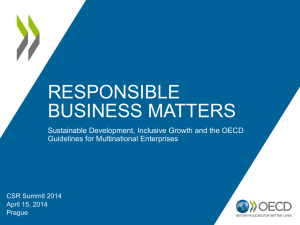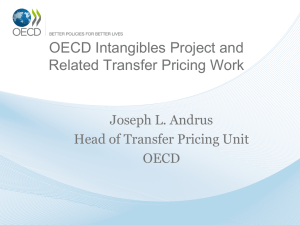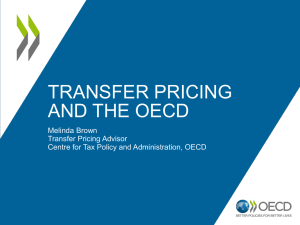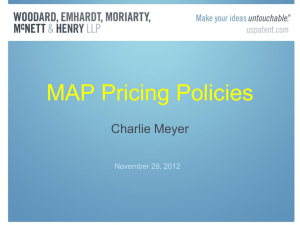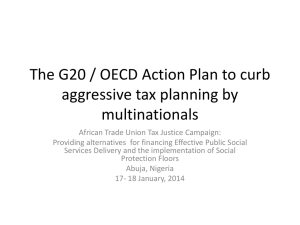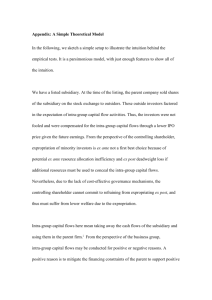Transfer Price - Ministerio de Hacienda
advertisement
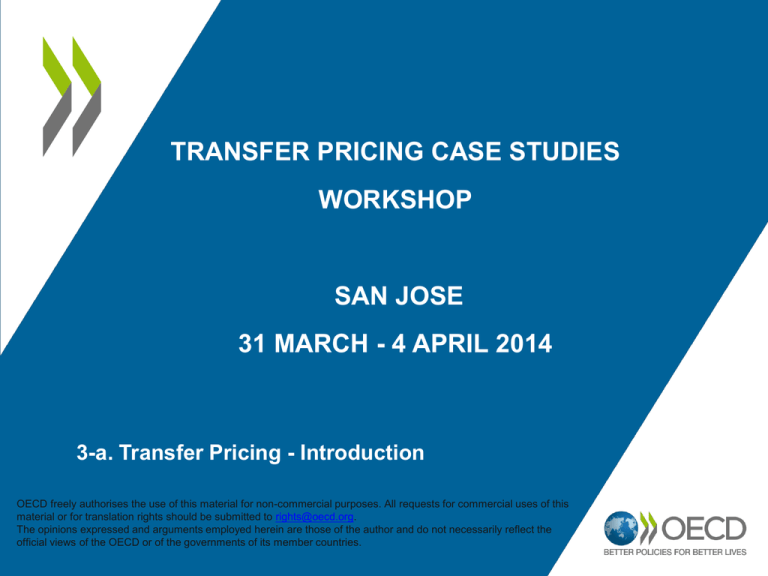
TRANSFER PRICING CASE STUDIES WORKSHOP SAN JOSE 31 MARCH - 4 APRIL 2014 3-a. Transfer Pricing - Introduction OECD freely authorises the use of this material for non-commercial purposes. All requests for commercial uses of this material or for translation rights should be submitted to rights@oecd.org. The opinions expressed and arguments employed herein are those of the author and do not necessarily reflect the official views of the OECD or of the governments of its member countries. 1 What is Transfer Pricing? Manufacturer Parent Co. Goods Wholesale distributor for Central American Region Distributor for each country End-Customers • Is there a transfer pricing issue? •What are the risks to businesses and governments? 2 What is Transfer Pricing? Parent Co France Regional Wholesaler Sub Mexico Distribution Sub Nicaragua Distribution Sub Costa Rica Distribution Sub Panama 3 Relevance of the Subject • Approximately 60-70% of world trade is carried on within Multinational Groups of Enterprises (MNEs) • Cross-border dimension of transactions... ...due to globalisation and economies of scale • Transfer prices ... are prices at which an enterprise transfers goods, services or intangible property to associated enterprises What is an “associated enterprise”? 4 Definition of “Associated Enterprises” • Definition in Article 9 OECD Model Tax Convention: “Direct or indirect participation in the – management, – control or – capital of an enterprise” • No minimum level of participation • Enterprises are associated where: – one enterprises participates in the management control or capital the other, or – the same person(s) participate in the management, control or capital of both 5 Participation in management, control or capital • Potentially quite wide • Domestic rules may refine or expand what transactions or arrangements are subject to the transfer pricing rules – Shareholding (de jure control): sometimes > 50% – De facto control, e.g. • • same directors in both enterprises sole customer or supplier – Association need not be proven 6 Participation in management, capital or control Company A 51% Company B Other shareholders Are A and C associated enterprises? 26% Company C 7 Control Company A 51% 51% Company C Company B 26% Company D Are B and D associated enterprises? 8 Relevance of the Subject Reliance on the Arm‘s Length Principle (ALP)... ...contained in Article 9 (1) OECD Model Tax Convention ALP entails the Separate Entity Approach, i.e. associated enterprises are taxed as if they were dealing wholly independently (i.e. at arm‘s length) “Where...conditions...in [the] commercial or financial relations [between the associated enterprises] which differ from those which would be made between independent enterprises” “...profits which would...have accrued...may be included in the profits of the enterprise and taxed accordingly” 9 OECD MTC and OECD TPG Arm’s Length Principle* embodied in Article 9 (1) OECD MTC OECD MTC basis for 3,600 legally binding bilateral Income & Capital Tax Treaties OECD TPG interpretative tool for Article 9 of the MTC * Also applicable to the UN Model Double Taxation Convention. ALP may also be mentioned in legislation (enacted in domestic law), regulations, rulings, case law or guidelines. 10 OECD Transfer Pricing Guidelines Consensus definition of the arm’s length principle Pricing methods and guidance used by countries around the world 11 OECD Transfer Pricing Guidelines • Chapter I: Guidance for applying the ALP • Chapter II: Transfer Pricing Methods • Chapter III: Comparability Analysis • Chapter IV: Administrative approaches to avoiding &resolving TP disputes (MAP, APAs, etc.) • Chapter V: Documentation • Chapter VI: Intangibles • Chapter VII: Intra-Group Services • Chapter VIII: Cost Contribution Arrangements • Chapter IX: Business Restructurings 12 Transfer pricing and profit shifting Manufacturer Country A Costs = 100 Profit A 50 100 150 200 250 Intra-Group Transaction Arm’s Length Transfer Price 150? 200? 250? 300? 350? Distribution Subsidiary Country B Resale Price = 300 Gross Profit B 150 100 50 0 - 50 Group Profit 200 200 200 200 200 13 Transfer Pricing and profit shifting Manufacturer Country A Costs = 100 Profit A = 150 Tax 10% = 15 Intra-Group Transaction Transfer Price 250 Distribution Subsidiary Country B Resale Price = 300 Profit B = 50 Tax 30% = 15 Total = 200 Total = 30 14 Transfer Pricing and profit shifting Manufacturer Country A Costs = 100 Profit A = 200 Tax 10% = 20 Intra-Group Transaction Transfer Price 300 Distribution Subsidiary Country B Resale Price = 300 Profit B = 0 Tax 30% = 0 Total = 200 Total = 20 15 Transfer Pricing Adjustment and Economic Double Taxation Intra-Group Transaction Manufacturer Country A Costs = 100 Transfer Price 300 Profit A = 200 Tax 10% = 20 Distribution Subsidiary Country B Resale Price = 300 Profit B = 0 Tax 30% = 0 Total = 200 Total = 20 Transfer Pricing Adjustment by B (50) 250 Profit A reported = 200 Tax 10% = 20 Profit B adj. =+50 Tax 30% = 15 Total = 250 Total = 35 16 Transfer Pricing Adjustment and Economic Double Taxation Manufacturer Country A Costs = 100 Profit A = 200 Tax 10% = 20 Distribution Subsidiary Country B Resale Price = 300 Intra-Group Transaction Transfer Price 300 Profit B = 0 Tax 30% = 0 Transfer Pricing Adjustment by B (50) 250 Profit B adj. =+50 Profit A reported = 200 Tax 30% = 15 Tax 10% = 20 Profit doubly taxed Total = 200 Total = 20 Total = 250 Total = 35 = 50 17 Elimination of Double Taxation by Corresponding Adjustment Manufacturer Country A Costs = 100 Profit A reported = 200 Tax 10% = 20 Intra-Group Transaction Transfer Price 300 Profit B adj. = +50 Tax 30% = 15 Corresponding adjustment by A (-50) Profit A reported = 200 Corr. adjustment - 50 Profit B adj. = 50 Profit A adjusted = 150 Tax 10% = 15 Tax 30% = 15 Distribution Subsidiary Country B Resale Price = 300 Total = 250 Total = 35 Total = 200 Total = 30 18 Questions and/or comments?

